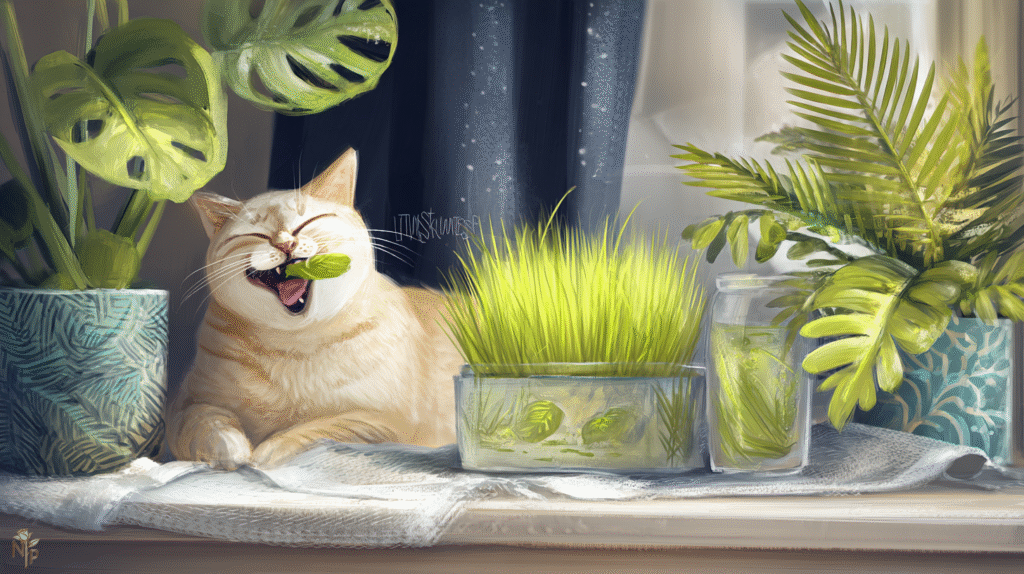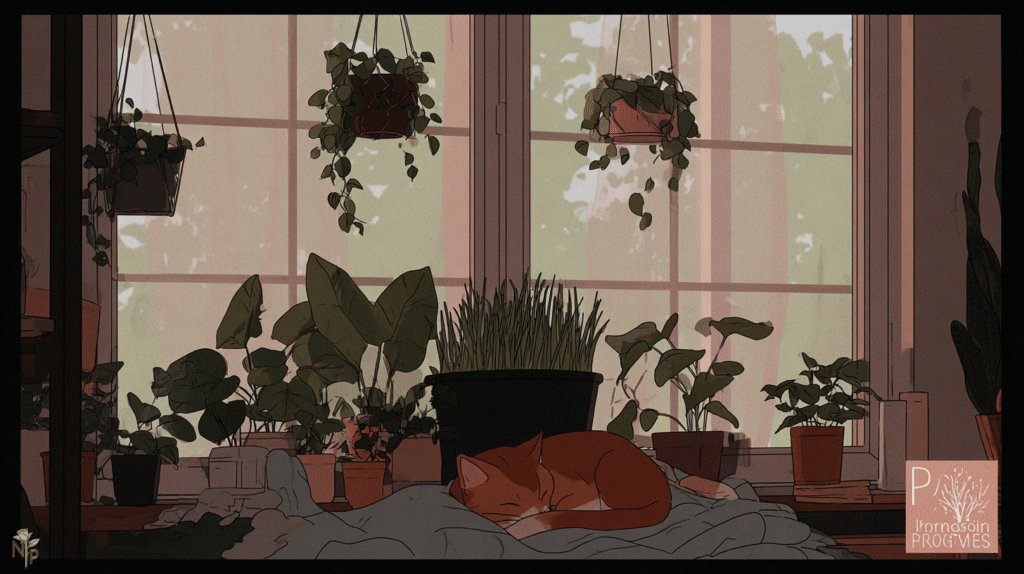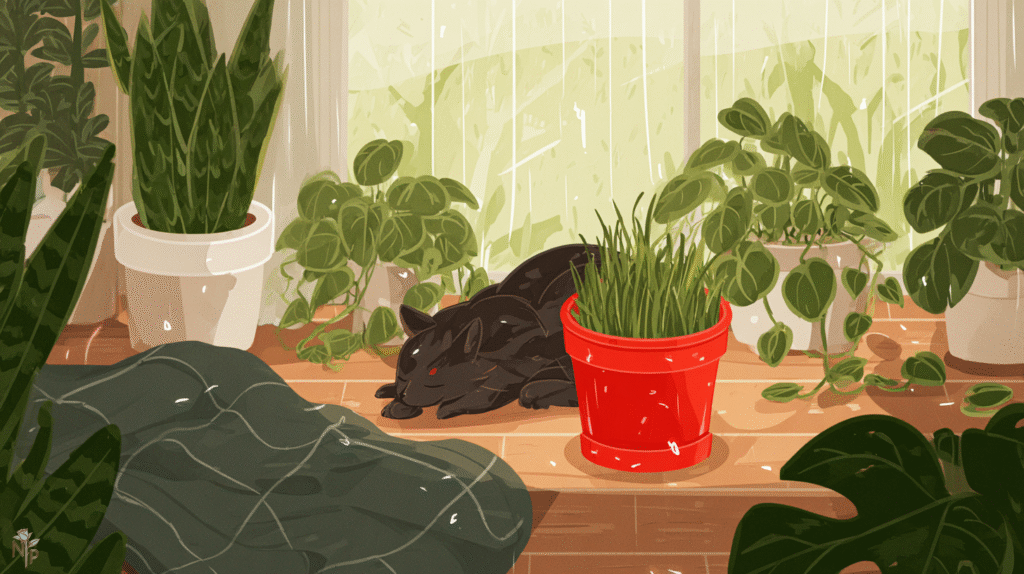I used to joke that my cat Luna was a vegetarian. Every morning, I’d find new casualties — bite marks on my monstera, demolished spider plant babies, and what remained of my Boston fern looking like it went through a paper shredder.
The breaking point? Coming home to find my prized bird of paradise — the $75 one I’d babied for two years — with every single leaf chewed down to nubs. I actually sat on my kitchen floor and cried. Luna just rubbed against my leg, completely unaware she’d committed plant murder.
I tried everything. Citrus spray (she licked it off). Aluminum foil barriers (she played with them). Moving plants to high shelves (she’s basically a furry acrobat). I was ready to either rehome my plants or live in a botanical prison where everything hung from the ceiling.
Then my friend mentioned cat grass. “It’s like a decoy plant,” she said. “Give them something they’re allowed to destroy.”
That sounded too simple. But three months later? My plants are thriving, Luna has her own personal salad bar, and I haven’t cried over murdered foliage once. Here’s why cat grass isn’t just a solution — it’s THE solution.

Understanding the Real Problem
Before cat grass saved my sanity, I needed to understand why Luna was so hell-bent on plant destruction.
Cats eat plants because:
- They need fiber for digestion
- It helps them process hairballs
- They’re bored or stressed
- The texture feels good
- Some cats just really like salad
Here’s the kicker — it’s completely natural behavior. Outdoor cats nibble grass all the time. Indoor cats? They’ll take whatever green thing you’ve got. Your expensive plants are just grass substitutes to them.
The scary part? Many houseplants are toxic to cats. Even “safe” plants aren’t meant to be feline food. I was lucky Luna never got seriously sick, but I spent way too many nights googling “is monstera toxic to cats” in a panic.
Why Cat Grass Works When Everything Else Fails
I’d tried every deterrent on the market. Here’s why they all failed and cat grass succeeded:
Spray deterrents: Luna either ignored them or seemed to enjoy the citrus flavor. Plus, constantly spraying chemicals on plants I touched seemed sketchy.
Physical barriers: She treated them like puzzle games. Aluminum foil became toys. Chicken wire made my living room look like a crime scene.
Hanging plants: Great until you run out of ceiling space or your cat learns to parkour off furniture.
Scolding/training: Have you met a cat? They don’t care about your disapproval.
Cat grass works because it’s not about stopping the behavior — it’s about redirecting it. You’re not fighting your cat’s instincts; you’re giving them an appropriate outlet. It’s like giving a teething puppy approved chew toys instead of letting them destroy your shoes.
Setting Up Your Cat Grass System
After wasting money on pre-grown containers that lasted three days, I developed a system that actually works:
What you need:
- Wheatgrass seeds (buy bulk online, way cheaper)
- Shallow containers (I use old takeout containers)
- Basic potting soil
- Spray bottle
- Sunny window
The three-container rotation:
This changed everything. Always have:
- One container being destroyed by cat
- One growing and almost ready
- One just planted
Start a new container every 5 days. You’ll never run out, and your cat never goes looking for alternatives (aka your plants).
Growing process:
- Fill container with 2 inches of soil
- Spread seeds THICK (cover all soil)
- Press down and spray with water
- Cover with plastic wrap for 2-3 days
- Once sprouted, remove plastic and put in sunny spot
- Ready in 7-10 days when grass is 4-6 inches tall
The first time Luna saw her grass, she attacked it like it owed her money. I knew immediately this was going to work.
Strategic Placement Is Everything
Just growing cat grass isn’t enough. You need to make it more appealing than your houseplants:
Put grass where your cat already hangs out. Luna’s grass lives by her favorite window perch. She sees it constantly.
Make it accessible. Floor level or on stable surfaces. If cats have to work to reach it, they’ll go for easier targets (your plants).
Multiple locations for multiple cats. My friend has three cats and three grass stations. No competition, no plant attacks.
Near problem areas. I put one container near my plant shelf — the scene of many crimes. It’s like offering the legal option right next to the illegal one.
The Unexpected Benefits
Besides saving my plants, cat grass has improved our lives in ways I didn’t expect:
Fewer hairballs: Luna used to hack up hairballs weekly. Now? Maybe once a month. The fiber really helps.
Better behavior: She’s less destructive overall. Having something she’s allowed to destroy seems to satisfy the urge.
Entertainment: Watching her graze is hilarious. She takes it so seriously, like she’s selecting wine.
Bonding activity: She gets excited when she sees me planting new grass. It’s become our thing.
Health monitoring: How much grass she eats tells me about her digestion. Eating tons usually means hairball incoming.

Troubleshooting Common Issues
“My cat ignores the grass”
- Rub it to release scent
- Sprinkle with catnip first
- Place it next to plants they DO attack
- Try different grass types (oat, barley, rye)
“The grass dies too fast”
- Use deeper containers with more soil
- Don’t overwater (mold kills it)
- Accept that 2-3 weeks is normal lifespan
- That’s why you rotate containers
“It’s ugly/messy”
- Yep. It’s not decorative, it’s functional
- Hide containers behind prettier plants
- Use nice planters if aesthetics matter
- Remember: ugly grass or destroyed plants?
“My cat still occasionally attacks plants”
- Make sure grass is always available
- Try moving threatened plants temporarily
- Some cats need adjustment time
- One plant nibble beats total destruction
The Cost-Benefit Analysis
Let’s talk money because this sold me completely:
Before cat grass:
- Replaced spider plant: $25
- Replaced pothos: $35
- Bird of paradise damage: $75
- Various casualties: $100+
- Vet anxiety: Priceless
With cat grass:
- Bulk seeds: $20 (lasts 6+ months)
- Containers: Free (reuse takeout containers)
- Soil: $5 bag lasts months
- Time: 5 minutes every few days
The math is clear. Cat grass pays for itself if it saves even one plant.
Making Peace with Plant Parenthood and Cat Parenthood
For months, I thought I had to choose between being a plant person or a cat person. Cat grass proved I could be both. It’s not about winning a battle against your cat — it’s about finding solutions that work for everyone.
My plants are thriving now. Luna is healthier and happier with her personal grass supply. I’m not constantly stressed about toxic plant consumption or finding more murdered plants.
Is it slightly ridiculous to be growing grass specifically for my cat to destroy? Maybe. But it’s way less ridiculous than the aluminum foil fortress I’d built around my plants. Or the time I hung every single plant from the ceiling and lived in what looked like a jungle gym.

Your Action Plan
Ready to save your plants? Here’s your quick start:
- Order wheatgrass seeds online today (seriously, bulk is so much cheaper)
- Gather 3-4 shallow containers
- Start your first container immediately
- Begin rotation system (new container every 5 days)
- Place strategically near cat’s favorite spots
- Watch your plants finally grow un-nibbled
Three months ago, I was ready to give up on having plants. Now people compliment my thriving indoor jungle and ask how I keep everything so perfect with a cat. The answer is simple: I don’t fight Luna’s instincts — I give her a better option.
Cat grass isn’t just a solution. It’s THE solution. Your plants will thank you. Your cat will thank you. Your security deposit will thank you. Trust me on this one. 🌿






